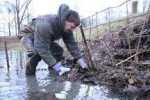Park officials condemn beaver dam

A chilly wind whipped across the lake at Greencastle's Jaycee Park Tuesday morning.
Park employee Dave Bault stood precariously on the lake's earthen dam, tightening the straps of his camouflaged hip waders and preparing to enter the frigid water.
As he stepped off the bank and into the knee-deep water, he kept his eye on a large pile of tree limbs and rotting leaves that stood on the water's edge.
He worked for quite a while to uncover a submerged pipe that runs hidden through the center of the dam and empties out on the other side. The purpose of the pipe is to keep the water in the lake at a controlled level and prevent it from overwhelming the dam.
While Bault understands the importance of maintaining the system, a family of beavers that has lived in the lake for many years does not.
For about a month, the animals -- said to be North America's largest rodents -- have been piling tree limbs and leaves on top of the drain, causing it to become clogged and making the lake level rise.
One morning when workers arrived, the lake had risen several feet and they had to work feverishly to uncover the drain so the lake would drain down.
"It's been a problem basically so far this winter," Bault said.
Bault said he and other workers have spent up to six hours in one day wading through knee-deep water and removing piles of debris from around the submerged drain. Most days it takes about an hour.
In an attempt to stop the beavers from reaching the drain, park workers constructed a wire fence around the area, but the beavers just filled it up with more sticks.
On Tuesday morning, Bault pointed to a pile of freshly cut limbs lying on the opposite side of the lake. He said the beavers placed them there the previous night.
"They like trees," Bault said, noting the fact that beavers tend to eat the outer bark of tree limbs and use the remains to build their dams and dens.
The beavers' den is located on the opposite end of the lake from the dam.
Since the beavers became a problem, park officials have tried to understand why they would target the drain.
"I've been told they don't like the sound of running water," Parks and Recreation Director Rod Weinschenk gave as the reasoning for the beaver's behavior.
He said he believes the beavers can hear the water running through the drain and emptying on the opposite of the dam and are trying to stop it. They work under the cover of darkness so park workers haven't actually caught them in the act.
They have tried repeatedly to capture the pesky animals but without success.
"We haven't been successful at trapping them," Bault said.
Park officials have borrowed a couple of live traps, but the beavers either aren't attracted to them or they are too smart to be caught. He said a couple of local animal trappers have agreed to try their hand at capturing the beavers. If that doesn't work, the final option would be to kill the animals.
Weinschenk said the DNR told him that since the beavers have proven themselves to be a nuisance and they are not considered endangered animals, park officials are well within their rights to take lethal action. But officials are reserving that as their last option.
"Right now we're trying to relocate the beavers," Weinschenk said. "Our first option is to try to live trap them."
